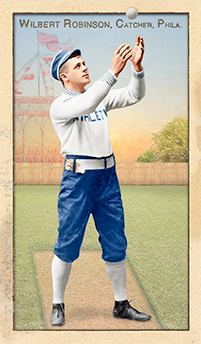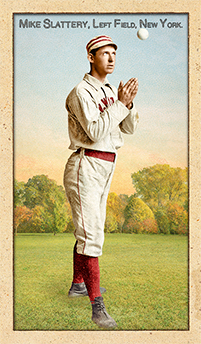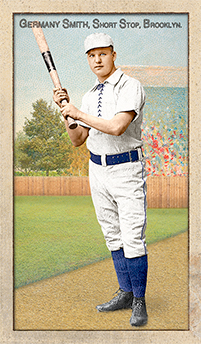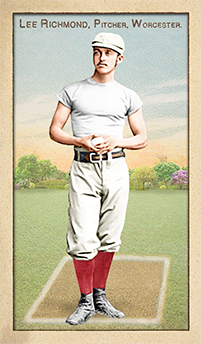
- Series: Beginnings: 1880's
- City: Worcester
- Team: Worcesters
- League: National League
J. Lee Richmond (1857-1929). One of the most noteworthy scholar-athletes of the 19th century, Richmond set many firsts in MLB: 1st regular left-handed pitcher, 1st to record five consecutive strikeouts, 1st minor-leaguer to single-handedly gain his team major-league status, 1st lefty to win 30 games, 1st M.D. to play in the majors, and, oh yes, 1st pitcher to hurl a perfect game. The latter accomplishment was noted at the time more for the unlikeliness of nine bare-handed fielders achieving “perfection” and Richmond always credited his team’s support as the key to his career highlight. Richmond also accomplished one last: his dominance for Brown University’s squad – while he was being lured in and out of the majors by Harry Wright and Frank Bancroft – so upset the Ivy League that they legislated against any “professionalism” in the college ranks, laying the foundation of NCAA policy to this day.
- Threw two no-hitters in 1879 (one was a 7 inning exhibition game). His perfecto came on June 12, 1880, giving Lee 3 no-hitters in 54 weeks!
- As with many early pitchers, Lee’s arm suffered from overwork, leading to his early departure for private medical practice back in Ohio
- Found his true calling as a teacher of Greek, physics, chemistry and math while coaching baseball, conducting the orchestra and serving as principal. A polymath indeed
- Lee Richmond did not appear in the Old Judge series as he had retired in 1886. This image is taken from a studio cabinet of unknown origin.
Here's an original scorecard from Lee Richmond's perfect game, the first in MLB history, June 12, 1880:
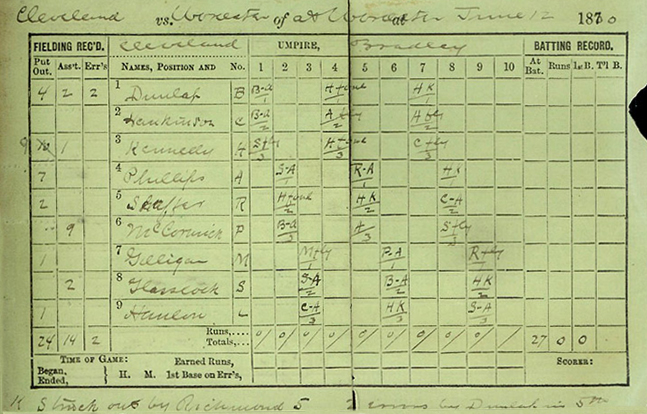
A few notes from the game:
- Only 6 months into the new decade, notice how the scorekeeper amended the date on a scorecard that was left over from the 1870s
- Richmond's opponent, the 1880 Cleveland Blues, were a good team. They finished 3rd in the National League with a 47-37 record & featured young standout talent such as Fred Dunlap, Jim McCormick, Jack Glasscock, Orator Shafer & Ned Hanlon. Richmond threw his gem against excellent competition.
- The Worcester Worcestors won the game 1-0, with Arthur "Foxy" Irwin scoring the game's only run in the 5th inning. The losing pitcher for the Blues, Jim McCormick, tossed a 3-hitter.
- The Worcestors weren't quite as stacked as the Blues (finished 5th with a 40-43 record), but featured some excellent players: Charlie Bennett, Dandy Wood, Art Whitney, Arthur Irwin, Harry Stovey & Bill McGunnigle.
- 12 of the 18 players who participated in the game have Ars Longa Art Cards: Dandy Wood, Lee Richmond, Arthur Irwin, Charlie Bennett, Art Whitney, Fred Dunlap, Frank Hankinson, Orator Shafer, Jim McCormick, Barney Gilligan, Jack Glasscock & Ned Hanlon.

- Series: Beginnings: 1880's
- City: St. Louis
- Team: Browns (AA)
- League: American Association
William H. Robinson (1859-1894) became one of the most proficient “on-base” artists of his day. He knew how to capitalize on the evolving base-on-balls rules during the mid-to-late 1880s and crafted outstanding years from fairly meager hitting. Yank played infield for a decade in the majors, 1882-92. He was a starter for Charles Comiskey’s St. Louis Browns during their pennant stretch from ‘85-88. No doubt Charlie had noticed the item in the Post-Dispatch proclaiming Yank “the best all-around player in the Union Association,” during its ‘84 season. Robinson had such a knack for waiting on the pitcher that his walks exceeded his hits the last six years in the majors. Opinions of Robinson’s defense vary but considering he eschewed the glove, some historians have credited him with superior skills.
- Yank had a notorious tussle with owner Chris von der Ahe in 1889 over a uniform the boss wanted changed. Robinson won the “strike” and the argument led him to jump to Pittsburgh’s Players’ League entry the next year
- Series: Beginnings: 1880's
- City: Philadelphia
- Team: Athletics (AA)
- League: American Association
- Hall: National Baseball Hall of Fame
Uncle Robbie (1863-1934). A durable catcher for 17 seasons with 3 teams, Robinson is credited as the 1st to play directly behind the plate at all times. Uncle Robbie once caught 5 games in two days. He also had 7 hits & 11 RBI in a single game. After his playing days were over, Robinson went on to manage for 18 seasons.
- Won 3 NL pennants as player
- Won 2 NL pennants as manager
- Won 5 NL pennants as pitching coach
- Elected to Hall of Fame: 1945

- Series: Beginnings: 1880's
- City: Chicago
- Team: Maroons
- League: Western Association
George Brinton McClellan Rooks (nee Ruckser) (1863-1935) had a vanishingly brief stint in the National League, seeing action in five games in left field for the Boston Beaneaters in May of 1891. He had a grand total of 20 plate appearances with 16 official at bats. He had twice as many walks as hits and ended his tour in the majors with a .125 average. He did score a run, allowing him to approach home plate from an alternate direction. This sketch doesn't do justice to a much longer professional experience for the young Chicagoan who had debuted with the Lincoln Tree Planters of the Western League in 1886 before moving on to the Northwestern League's Oshkosh franchise to finish the season. George remained in the league the following year with the LaCrosse Freezers where he was a regular. He hit .333, higher than any teammate with as many at bats. He showed both power and speed with four home runs and 70 stolen bases. Rooks got a cup of coffee in '88 with his hometown Maroons but got into only eight games before being shipped out to the Lima Lushers of the Tri-State League. 1889 would be the second and last time George played an entire season for one team, this time with the Detroit Wolverines of the International League. He was one of four to play 112 games and he produced a fine .303 average, second on the club among regulars.
- Following his sojourn in Boston, Rooks finished out his minor league career primarily close to home with clubs in Wisconsin and Michigan, including the intriguing bi-city squad from Ishpeming-Negaunee in 1892
- George strayed south for his swan song in '93 with Vicksburg of the Mississippi State League
- Although Baseball Reference data list George as right-handed, the Old Judge poses when he was with the Maroons depict a lefty both at bat and throwing
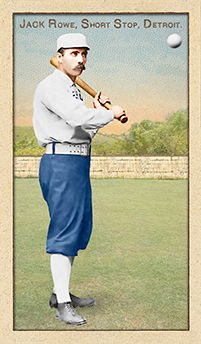
- Series: Beginnings: 1880's
- City: Detroit
- Team: Wolverines
- League: National League
John Charles Rowe (1856-1911) played a decade in the major leagues for two teams, the Buffalo Bisons and Detroit Wolverines before finishing out his career with the Alleghenys and Players’ League Bisons back in Buffalo in 1890. It was his skill at bare-handed catching in the minors that attracted the Bisons’ attention in 1878, but his September call-up impressed with the bat as well when Rowe hit .353. That debut led to a seven-year tenure in upstate NY where he gained fame as part of the “Big Four” with Dan Brouthers, Hardy Richardson and Deacon White. The quartet were formidable batsmen, but a lack of pitching doomed the franchise to mediocre results. In September ‘85 the four were sold to Detroit and remained a unit until the team folded after the ‘88 season. By 1887 Rowe was primarily a shortstop and helped the club win it all, pennant and post-season, for the high-water mark of the Wolverines. Victims of the early reserve system, Rowe and White tried unsuccessfully to return to Buffalo in ‘88 as co-owners, but were held to a sale to Pittsburgh. They did make good on their plan as a Players’ League entry in 1890 for a final year in the majors for both.
- Ran a cigar store in retirement and, per the January 1899 The Sporting Life was “one of the most contented men in Buffalo these days”
- Series: Beginnings: 1880's
- City: Indianapolis
- Team: Hoosiers (NL)
- League: National League
- Hall: National Baseball Hall of Fame
“The Hoosier Thunderbolt” (1871-1942). In a 10 year career: (8) 20-win & (4) 30-win seasons; 5x strikeout & 2x ERA leader; won pitching’s Triple Crown in 1894. Rusie threw hard for the era, once hitting HOFer Hughie Jennings in the head, inducing a 4-day coma. This event was influential in increasing the pitching distance to 60’6″ from its original 50 feet.
- Once was traded for Christy Mathewson
- Suffered hearing loss due to line drive to the head
- Elected to Hall of Fame: 1977
- Series: Beginnings: 1880's
- City: Chicago
- Team: White Stockings
- League: National League
James Edward Ryan (1863-1923) was one of the stand-out players of the 19th century. When he retired in 1903 after 18 ML seasons Ryan ranked in the top 10 in most offensive stats. The first veteran’s committee of the Hall of Fame convened in 1936 and did not elect a single player from that era. Ryan got no votes despite ranking among the best of his day. Ryan was no shrinking violet. He was known as a battler who would punch a reporter or a conductor who wouldn’t find him a berth. In 1888 he led the NL in HRs, hits, doubles, total bases and slugging percentage.
- Career .306 hitter with 118 lifetime home runs when few were hit
- Despite his success, Ryan soured on the game. After his retirement he counseled against making a career in pro-ball, pointing to the few players who made it past age 35
- Series: Beginnings: 1880's
- City: Philadelphia
- Team: Quakers
- League: National League
Alexander Bennett Sanders (1865-1930) pitched for the Quakers, Athletics and Colonels over a 5 year career. His odd delivery left him facing 2nd base and vulnerable to the bunt. Nevertheless, Sanders went 80-70 with a 3.24 ERA. Perhaps his fielding limitations led to his yielding 2 runs despite hurling a no-hitter against the Orioles on 8/22/92—the 1st no-no where the loser scored.
- Sanders joined the ill-fated Player’s League with Philadelphia in 1890
- As a rookie, nearly achieved a 2nd no-hitter, giving up a one-out single in the 9th

- Series: Beginnings: 1880's
- City: Detroit
- Team: Wolverines
- League: National League
Frank S. Scheibeck (1865-1956) enjoyed a two-decade career that began with the Duluth Freezers and ended with his hometown Tigers at age 41 in 1906. Frank had some distinguished moments over this long haul. With the Toledo Maumees of the AA in 1890, he was the league leader for shortstops in several defensive categories while hitting .282. His performance could careen up and down, however, leading to many assignments in the minors. Undoubtedly, Frank regaled his grandkids with the tale of his role in one of the greatest ninth-inning comebacks ever: a bases-loaded double that sparked his Cleveland Blues against the Washington Senators, overcoming a 13-5 deficit on May 31, 1901.
- Remarkably, on April 25, 1901 in their first American League game, Detroit overcame a ten-run disadvantage, also in the bottom of the ninth versus the Brewers
- Played for seven major-league teams from 1887-1906
- Played for three different professional baseball teams in Detroit across three different leagues: Detroit Wolverines, NL, 1888; Detroit Tigers, WL, 1895-96; Detroit Tigers, AL, 1906.

- Series: Beginnings: 1880's
- City: Des Moines
- Team: Prohibitionists
- League: Western Association
Luke Schildknecht was a minor league catcher in the late 1880s in the midwest. Photographed by the Old Judge crew for their 1888 series, Luke appears in three known poses in a Des Moines uniform. The Baseball Encyclopedia lists Luke on the 1888 Des Moines Prohibitionists' roster, playing 26 games with a .237 BA. They indicate the same stat line for the ’88 Sioux City Corn Huskers, which had taken over the Des Moines club mid-season. Interestingly, only three players on that team lack personal data, with Schildknecht and battery mate Frank Wells being two of them. The tandem seem to have arrived and left the team at about the same time.
Dennis Pajot’s The Rise of Milwaukee Baseball documents that the Cream City team signed both Schildknecht and Wells prior to the 1889 season. However, Schildknecht is listed as the fourth-string catcher for the squad and does not appear in the historical record for the team at any time. Despite not making the team in Milwaukee, the Old Judge editors changed Luke's team designation from Des Moines to Milwaukee and continued to use the Milwaukee designation on Luke's cards throughout the rest of the Old Judge run.
- Yep, I was confused too. Took me a few years to realize that the uniform Luke is wearing in this image is a Des Moines uniform. Reversing the trend that the Old Judge guys started 128 years ago, I changed Schildknecht's team designation on this card in September, 2017, from Milwaukee to Des Moines. Balance is restored. Six cards were previously released with the Milwaukee team designation.

- Series: Beginnings: 1880's
- City: Cincinnati
- Team: Red Stockings (AA)
- League: American Association
Gustavus Heinrich Schmelz (1850-1925) managed minor and major league teams for 15 years, was popular with his players and had modest success at both levels. He was denied a pennant as second-place was the highest any team achieved under his direction. Gus led his hometown Columbus Buckeyes in the American Association in 1884 where he witnessed two of his staff hurl no-hitters within a week. Interspersed with minor league assignments, Gus managed Cincinnati’s Red Stockings for three seasons, returned to Columbus (then the Solons), and also had three NL teams: the St Louis Maroons, Cleveland Spiders and Washington Senators. Gus managed the Atlanta franchise of the newly formed Southern League in 1885 and witnessed the tragic death of one of his players. A violent collision at first base caused a ruptured liver for Lewis Henke. Schmelz had the sad duty of conducting the funeral for his strapping first-sacker who was the runner when injured on Aug 14. The Atlanta Constitution noted Henke was “…perhaps the most popular player in the Southern League.”
- Schmelz compiled a major league record of 624 wins against 703 losses (.470)
- Series: Beginnings: 1880's
- City: Indianapolis
- Team: Hoosiers (NL)
- League: National League
Otto H. Schomberg (1864-1927) played 1B and OF for parts of three seasons in the Major Leagues, for the Alleghenys and Hoosiers. He was a fine hitter but cursed with an erratic throwing arm which led to the demise of his big league career. He shuttled between first and the OF as managers tried to find a place for this promising slugger. Schomberg was also plagued by heart problems and suffered a bout of malaria that combined to end his hopes for a baseball future.
- During his only full season in 1887, Schomberg was among the top ten batters in the NL and received the Spalding Ivory Bat award as his team’s hitting leader
- Schomberg had an entrepreneurial talent that led to a successful career in the timber industry

- Series: Beginnings: 1880's
- City: Philadelphia
- Team: Quakers
- League: National League
William Frederick Schriver (1865-1932) was a durable catcher for several mostly National League teams from 1886 through 1901. His debut for the AA’s Brooklyn Grays was his only stint outside the NL. Pop had a solid .264 lifetime batting average over a 14 year major league career. During his time with Cap Anson’s Colts, to promote a game with the Senators, battery-mate Clark Griffith made a 555’ “toss” to Schriver (off the Washington Monument). Accounts differ on Pop’s performance and Griffith later said Schriver dropped the ball. In any case, history has credited Gabby Street with the first successful accomplishment of the stunt, largely on the testimony of Griffith who by then was owner of Street’s Senators. In 800 games, Schriver made 720 hits in 2,727 at-bats.
- During 1894, the year of the D.C. feat, Pop was among the league leaders in most defensive categories
- In 1901 Schriver led the league in throwing out runners attempting to steal
- Series: Beginnings: 1880's
- City: Indianapolis
- Team: Hoosiers (NL)
- League: National League
John Emmett Seery (1861-1930) played the outfield for and with some of the game’s most colorful characters in the early era of baseball. He debuted with the Baltimore Monumentals in 1884 Seery led his Union League team in batting with a .311 BA. Played under John Montgomery Ward (Ward’s Wonders of Brooklyn) and Mike “King” Kelly (Kelly’s Killers of Cincinnati) during a tumultuous age as teams and leagues were starting and folding abruptly.
- In ’86 with the St Louis Maroons, led the league in games played with 126
- Followed the team’s owner, Henry Lucas, to Indianapolis with the Hoosiers for 3 years
- Demonstrating a good eye, consistently ranked in the top 10 in walks

- Series: Beginnings: 1880's
- City: Cincinnati
- Team: Red Stockings (AA)
- League: American Association
William I. Serad (1863-1925) pitched for two major-league teams, the Buffalo Bisons and Cincinnati Reds, from 1884-88. His entire time in pro ball included seven teams over eight years. His performance in the minors was consistently better, earning him chances where he failed to rise above mediocrity, attested by his ML 35-55, 4.13 ERA record. Billy surrendered 34 HRs and was particularly victimized by Anson’s White Stockings who jumped on 15 of his offerings. He appears to have been plagued by nerves, in evidence during his debut when he walked 3 and scored 2 on wild pitches in the first inning. As a weak hitter, the manager had nowhere else to put him until he could settle down. Unlike better-hitting pitchers, Billy had to make it solely on his mound prowess which didn’t quite measure up.
- Billy wasn’t a total failure by any means. In his rookie year he won 16 of the Bisons’ 62 victories en route to a third-place finish

- Series: Beginnings: 1880's
- City: Philadelphia
- Team: Athletics (AA)
- League: American Association
Edward William Seward (nee Sourhardt) (1867-1947) was just 20 years old when he teamed with Gus Weyhing on the mound as the Athletics’ formidable starting duo, combining for 51 of the team’s 63 wins. “Kid” Seward had begun in the minors at 16 so was something of a veteran when Philadelphia made him their ace. Ed started and finished 110 games in ’87 and ’88, winning 60. He was on fire in 1888, leading the American Association in strikeouts and shutouts while hurling a no-hitter against the Cincinnati Red Stockings on July 25. He went 35-19 with a 2.01 ERA. The phenom began to burn out the following year but still posted a strong 21-15 season. His final year with the A’s, 1890, saw the Kid fall off to 6-12. A brief look with the Cleveland Spiders the following year was his last, starting a mere three games and winning two. His mound-mate Weyhing matched his no-hitter a week after Ed’s. Nicknamed “Rubber Arm,” Weyhing indeed proved the more durable, going on to a 14-year career. Nevertheless, for a couple of seasons, these two strong-armed youngsters really lit it up in the city of brotherly love.
- Seward’s overall record was 89-72 with a 3.40 ERA and 589 strikeouts
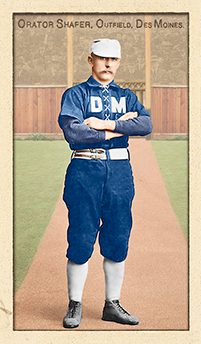
- Series: Beginnings: 1880's
- City: Des Moines
- Team: Prohibitionists
- League: Western Association
George W. Shafer (1851-1922) still ranks tenth all-time in outfield assists. The right fielder extraordinaire also continues to hold the single-season record with 50 runners cut down in 1879. Known for jawing at himself out in right if he didn’t have an umpire nearby to harangue, “Orator” was far from all talk. He had great seasons at bat and perennially ranked among the best outfielders of his day. Shafer began with the Hartford Dark Blues of the NA in 1874. Like many in the early decades of baseball, he moved around a lot. By the time he returned for a second stint with the Athletics in 1890, he had played for ten teams in 14 years. He had a great year at bat for the Indianapolis Blues in ‘78 where his .338 average was sixth in the NL. Four times he led the league in outfield assists. Orator was a key member of Cap Anson’s White Stockings, batting .304 the year he set the assist record. From 1887-89 the volatile Shafer made his living with minor league squads where he hit well and also drew a suspension for decking an umpire.
- Shafer’s final ML season was back in Philly where he was joined by younger brother (Zachary) Taylor at 2nd base
- Orator had an even 1,000 hits, good for a lifetime .282 average
- Shafer’s uniform color on this card was changed in May, 2017 from black to blue to reflect recent reliable research by Craig Brown & friends at Threads of Our Game. Two cards had been previously released featuring a black uniform.
- Series: Beginnings: 1880's
- City: Philadelphia
- Team: Athletics (AA)
- League: American Association
William A. Sharsig (1855-1902) was the esteemed GM and field manager for the Philadelphia Athletics in both their incarnations from 1886-1891. As the founder and co-owner of the original Athletics franchise, Sharsig named himself field general several times. When the Players’ League folded in 1891, he continued in baseball with the Western League’s Indianapolis club.
- His prestige in MLB prompted the NL to invite him to consult on the decision to move the mound to 60’6” in 1893
- A Philadelphian born and bred, Sharsig died there at age 46 on the eve of accepting Connie Mack’s offer to return as business manager

- Series: Beginnings: 1880's
- City: Washington, D.C.
- Team: Nationals
- League: National League
George Quintus Shoch (1859-1937) had a decade-long career in the majors, beginning in 1886 with the Washington Nationals and ending in 1897 with the Brooklyn Bridegrooms. He compiled a respectable career average of .265. George was a valuable utility man, playing outfield, short and 2nd. He demonstrated good plate discipline, striking out only 129 times in 2,924 plate appearances. George's best year was his first in Brooklyn, 1894, where he hit .317 and struck out a mere six times in 65 games. At the close of his big league tenure, Shoch showed his usual consistency, playing in 85 games for the Bridegrooms and hitting .278. Durability and consistency were hallmarks of Shoch's career.
George began pro ball in 1885 with the Eastern League's Wilmington Blue Hens, who also played in Atlantic City, and with the Hartford Babies of the Southern New England League. He remained in the game until age 46, closing out with Binghamton and Amsterdam of the New York State League. Shoch’s last games were with the tri-city team of Amsterdam/Gloversville/Johnstown where the Jags shared their talents for three seasons in three upstate NY towns.
- For one season, 1900, George was player-manager for the Philadelphia Athletics/Harrisburg Ponies of the Atlantic League
- Henry Chadwick wrote that Shoch was “the most versatile utility man the Brooklyn club has ever had”
- Shoch's uniform color on this card was changed in July, 2017 from black to blue to reflect recent reliable research by Craig Brown & friends at Threads of Our Game. One card had been previously released featuring a black uniform.
- Series: Beginnings: 1880's
- City: New York
- Team: Giants
- League: National League
Michael J. Slattery (1866-1904) was an outfielder for five teams over five seasons, including the 1888 Champion NY Giants. He debuted for the Union Association’s Boston entry (the Reds) in 1884 during that league’s only season. Slattery returned to MLB in 1888 with the NL’s Giants for two years before jumping to the NY Player’s League team in 1890. He closed his career with the Cincinnati Reds and Washington Statesmen in ’91.
- Averaged .251 at the plate over his ML tenure
- Best year was in the PL, with a .307 BA, 126 hits, 5 HRs and 18 steals
- Series: Beginnings: 1880's
- City: Brooklyn
- Team: Bridegrooms
- League: American Association
George J. Smith (1863-1927). A shortstop for 5 teams over 15 seasons, Germany once committed 7 intentional errors in a game to undermine the boasting of his pitcher that day, Phenomenal Smith. 14 errors were committed that day, the Bridegrooms lost 18-5, Germany and others were each fined $500, and Phenomenal was released. A below average hitter, Germany was an excellent defender and routinely finished in the league’s top five in many defensive categories for shortstops.
- Series: Beginnings: 1880's
- City: Baltimore
- Team: Orioles
- League: American Association
John Francis Smith (1864-1952). Despite his name, Smith never had a winning season in the major leagues, going 54-74 for 6 different teams over 8 seasons. Smith earned his nickname after striking out 16 batters in a minor league game. Before one game, Smith bragged he was so good that he did not need his teammates; they proceeded to commit 14 errors & Smith lost the game 18-5. The players were fined $500 and Smith was released.
- Discovered Christy Mathewson
- Won a minor league batting title
- Smith's uniform color on this card was changed in March, 2017 from black to blue & red to reflect recent reliable research by Craig Brown & friends at Threads of Our Game. Nine cards had been previously released featuring a black uniform.
- Series: Beginnings: 1880's
- City: Boston
- Team: Beaneaters
- League: National League
- Hall: Canadian Baseball Hall of Fame
Charles Marv Smith (1856-1927). From Nova Scotia, Canada, Smith was an infielder for 10 different teams over 12 professional seasons. On April 17, 1890, Smith walked his first 5 times up at bat and was hit by a pitch the 6th time, becoming the 1st player in Major League history to come to bat 6 times in a game and not record an official At Bat.
- Elected to Canadian Baseball Hall of Fame: 2005
- Series: Beginnings: 1880's
- City: Boston
- Team: Beaneaters
- League: National League
William Jefferson Sowders (1864-1951) pitched for the Boston Beaneaters in 1888 and ’89, moved that year to the Pittsburgh Alleghenys and left MLB after the 1890 season. He compiled a 29-30 record, striking out 205 with a 3.34 ERA. Nicknamed “Little Bill,” this 6’ right-hander was a head taller than most of his peers. Bill was the middle of three Sowders brothers to play in the major leagues. Elder brother Len pitched for the Baltimore Orioles in ’86 and John played for the Hoosiers, the KC Cowboys and Ward’s Wonders of Brooklyn over three seasons.
- Played two minor league seasons (’87 & 91) in the Northwestern League for St. Paul and Joliet of the Illinois-Iowa League

- Series: Beginnings: 1880's
- City: Chicago
- Team: White Stockings
- League: National League
Charles Wellington Sprague (1864-1912) pitched for nine teams from 1887 through 1891, three of which were in the major leagues: the National League’s Chicago White Stockings and Cleveland Spiders, and the Toledo Maumees of the American Association. His other experience was primarily in the Western Association with Jamestown of the New York-Pennsylvania League being his final stop. With the big clubs, Sprague had a respectable 10-7 record during three seasons with a 4.51 ERA. The lefty played a little outfield when not on the mound. For Toledo, Charlie was the fourth starter with Egyptian Healy being the ace. The team finished fourth in 1890, the year so many stars bolted to their start-up “Players’ National League of Professional Base Ball Clubs” (aka the Players’ League or “Brotherhood.”)
- The Goodwin guide editors note that Charlie’s Old Judge images are unusual in depicting him in two different team uniforms in the same season: Chicago’s White Stockings and Maroons in 1888



